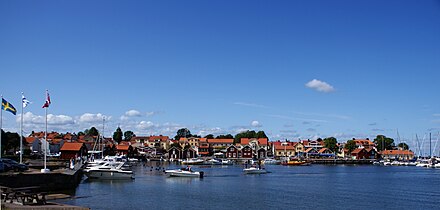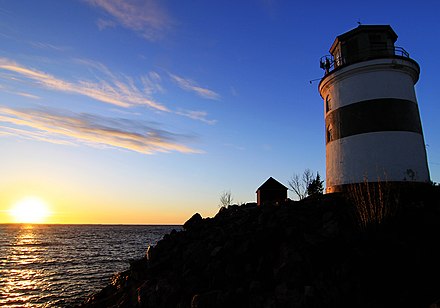Uppsala County, Uppsala län, is in eastern Svealand in middle Sweden, and has around 360,000 inhabitants. The county makes up most of the Uppland province; the south-eastern part belongs to Stockholm County. It borders Västmanland in the west, and Gästrikland in the north, and nearly has a quadripoint with Dalarna in the north-west.
Cities

As other Swedish counties, Uppsala County is divided between municipalities (kommuner), each with a dominant city or town.
- Uppsala is a university city, with the largest cathedral in the Nordic countries.
- Östhammar is a coastal town, famous for the Walloon iron industry, and the northern outskirts of the Stockholm archipelago.
- Tierp is a quaint town between Uppsala and Gävle. Its municipal territory contains the northernmost stretch of the Roslagen coast.
- Älvkarleby at the outlet of Dalälven River, considered the natural border to Norrland. The Dragon's Gate, a Chinese-themed hotel, can be found here.
- Knivsta is a modern suburb with heritage from the Viking age, and many historical artifacts.
- Enköping , "Sweden's nearest city", is a quaint port city with acclaimed public gardens.
- Håbo , with Bålsta as the municipal seat, is functionally an outer suburb of Stockholm.
- Heby is a rural municipality with deep forests.
Other destinations
- Uppsala countryside consists of the suburbs and farmlands around Uppsala contain Carl Linnaeus' botanical garden, the Lennakatten museum railway, and many archaeological sites.
- Skokloster Palace outside Enköping
Understand
The Saga Of Uppland
In her Wonderful Adventures of Nils Selma Lagerlöf writes that Uppland was originally the poorest among Sweden's provinces. To make ends meet, Uppland went begging for alms around the country. From Dalarna Uppland got the mouth of Dal River, from Scania the fertile Uppsala plain, from Bergslagen rich deposits of ore, from Bohuslän Stockholm archipelago, and so on, and soon Uppland prospered. When the other provinces saw this they agreed that Uppland was the most clever among Sweden's provinces, and that she ought to rule the others.

 See also: Vikings and the Old Norse
See also: Vikings and the Old Norse
Though Swedish provinces are usually the foundation of folk culture and local patriotism, Uppland lacks a unifying identity, and very few inhabitants think of themselves as "Upplanders". The area is very diverse, with rich mining deposits and dense forests in the north, fertile plains in the south, and a maritime coastal region in the east. Historically, the people of Uppland have been the first to adopt international trends arriving in Sweden via Stockholm, creating a more cosmopolitan but less traditional local culture. If anything is typical for Uppland, it would be the very absence of typical traits. Today, the province is much characterized by the gap between the bustle of Stockholm and Uppsala, and the quiet northern forests.
Without tall mountains, Uppland was one of the last Swedish provinces (landskap) to rise from the Baltic Sea after the Ice Age. Still in 1,500 BC, at the beginning of the Iron Age, most of today's land surface was below sea level. Though the land is young, it is among the most fertile in Sweden, and allowed the Suiones, svear to found a cities, such as Uppsala, Birka and Adelsö during the Viking Age in the 8th to 11th century.
Around AD 1000 Sweden was christianized and the organized into a unified kingdom, with Sigtuna as its first capital. As Sigtuna was sacked by pirates in 1187, Stockholm was founded to protect Mälaren, and later became the national capital. Uppsala was the site of a pagan temple, which was torn down in the late 11th century, as Christianity arrived. A century later, the city became the seat of the Church of Sweden.
From the Middle Ages, Uppland was an international forerunner in metallurgy. In the early 17th century, blacksmiths from Wallonia founded several workshops around Östhammar, and forged weapons which were used to establish the Swedish Empire (see Nordic history).
Since the Industrial Revolution, Stockholm and Uppsala have grown, while the minor towns now function as extended suburbs of these cities. With nearly 1.5 million inhabitants, Uppland is Sweden's most populous province.
Roslagen is the coast and archipelago of Uppland, also consisting of Norrtälje, Lidingö, and the northern Stockholm archipelago.
Get in
The search engine Resrobot can be used for all domestic public transport in the area.
By plane
- Stockholm Arlanda Airport (Sigtuna) is Sweden's largest airport, with flights from all across Europe, North America and Asia. There are direct trains from Arlanda to Uppsala, which depart from SkyCity between terminal 4 and 5 (ticket sales there), not from the two other stations at Arlanda.
- Stockholm-Bromma Airport (Stockholm/Västerort) mostly serves short-range flights. Bus to Stockholm and then train.
By ferry
Ferries from Finland and Estonia arrive at Stockholm and Kapellskär (in Norrtälje). See Tallink Silja Line and Viking Line.
By train
Trains from Copenhagen, Oslo and Gothenburg end at Stockholm Central Station. Change train in Stockholm to go to Uppsala or Enköping. Trains from Northern Sweden stop in Uppsala. Tickets are sold by SJ. There are frequent trains from Stockholm to Uppsala, both SJ trains, and local Stockholm trains. If you travel between Stockholm and Uppsala on the local Stockholm (SL) trains you need both SL and UL tickets. Such multiple tickets can bought over desk on SL centers in Stockholm or UL Center at Uppsala station, or from SJ, not onboard or in SL machines.
By bus
- Tapanis Buss has a route between Stockholm and Tornio, Finland serving coastal region along road E4
- FlixBus
Get around
Public transport in Stockholm county (including Sigtuna and Norrtälje) is run by SL. In Uppsala County it is run by Upplands lokaltrafik. There is a fairly large city bus network in Uppsala.
In the countryside, driving is the most practical option. The E4 passes through Knivsta, Uppsala, Tierp, and Älvkarleby; see E4 through Sweden.
See
_2.JPG/440px-Skokloster_castle_(by_Pudelek)_2.JPG)
Industrial heritage
Öregrund, Älvkarleby and Tierp have several metal works, bruk. Many of them were founded by Walloons during the 17th century.
Palaces
Uppsala County has a large collections of palaces and castles, slott, most of them open to the public to some extent. Noblemen and industrialists built themselves buildings in rural Uppland.
- Ekolsund Castle (Ekolsunds slott), 59.650788°, 17.367024°, +46 171-47 22 00. In Enköping municipality, it was the summer recidency of King Gustavus III. It has a famous arboratory which can be seen during pre booked tours.
- Grönsö Manor, 59.472440°, 17.245907°, +46 171-870 84. The garden is open daily; tours 25 May-17 Sep: Sa Su, and 24 Jun-13 Aug: daily at 13:00. 17th-century castle by lake Mälaren which is the private recidency of the von Ehrenheim family. The palace interiors are only accessible through guided tours. Garden: 40 kr, guided tour: 150 kr
- Haga Castle (Haga slott), 59.604204°, 17.049679°, +46 171-41 47 00. Castle near Enköping which is today luxury a conference hall, hotel, SPA and restaurant. (Not to be confused with Haga of Solna!)
- Skokloster Castle (Skoklosters slott), 59.703065°, 17.621403°, +46 8 402-30-60. May & Sep: Sa–Su 11:00–16:00. Jun–Aug: Daily 11:00–17:00. On a peninsula in Lake Mälaren in the southern part of Uppsala County, it is one of the world’s finest baroque castles and the greatest private palace ever constructed in Sweden. Admissions to the castle are free for the ground floor while guided tours are 80 kr and audio guides are 40 kr
- Uppsala Castle (Uppsala slott), 59.85344°, 17.63564°, +46 18-544811. It was built in the 16th century by the Vasa dynasty, both as a royal residency and as a military fortification. Some of the space is also being filled by Uppsala Konstmuseum (undefined, +46 7272482. Daily 12:0/–16:00), a local art museum, and Fredens hus (undefined, +46 18-500008. W–F 15:00–18:00, Sa Su 12:00–18:00); a museum housing exhibitions concerning peace, conflict and human rights. During the summer you can visit Vasaborgen (undefined, +46 703-907989. Open daily June 11th–August 13th and on weekends late August 10:00-18:00); Uppsala Castle's 16th century castle ruins. Due to its location on the top of Uppsalaåsen the Castle area offer some of the best views of Uppsala. Free admission to Konstmuseet & Fredens hus. Vasaborgen costs 100 kr
- Örbyhus Castle (Örbyhus slott), 60.199990°, 17.709175°, +46 29-520300. Tours: May 16–Sep 6: Sa Su at 13:00, Jun 23–Aug 2, Daily at 13:00 and 15:00. In Tierp municipality. In 1577 the Swedish king Erik XIV died during his imprisonment here. According to legend he was poisoned through a plate of pea soup! The Castle area is free. Guided tours are 60 kr
Do
Except Uppsala, most of the county is rural, and good for outdoor life, such as hiking, water sport, and cross-country skiing.
- Gårdsjö Moose tour (Gårdsjö Älgpark), Gårdsjö 127, Heby Municipality, +46-70-3536060. Opening hours vary greatly throughout the year. See calendar on their website. A wagon tour around a 25-hectare (~60-acre) enclosed area populated by 10 moose. The tours take about one hour and are in Swedish and English. It is also possible to stay overnight in a cottage within the moose territory. Adults 240 kr, children 3-12 120 kr, children 0-2 free
Eat
See also: Nordic cuisine
A maritime province, fish has been a staple of the Uppland cuisine. Fish is distributed through a market in Stockholm.
Go next
- Gävleborg County is the gateway to Norrland.
- Stockholm County; while the county is dominated by Stockholm, Sigtuna and Norrtälje are near Uppsala
- Åland is an autonomous Swedish-speaking archipelago in the Baltic Sea, which is part of Finland.